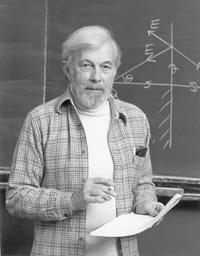
Retired physics professor, Dr. E. Robert Beringer, died May 27.
Professor Beringer was born in western Pennsylvania in 1917 and completed his undergraduate work at Washington and Jefferson College in 1939. He then was admitted to Yale as a graduate student in physics and chose to work in the new field of microwave spectroscopy with Professor Carol Montgomery.
After the bombing of Pearl Harbor, Montgomery left Yale to join the Massachusetts Institute of Technology Radiation Laboratory and Professor Beringer joined her upon completion of his Ph.D. degree in 1942. The so-called “Rad Lab” was formed under wartime pressures to develop and exploit the early British success in radar.
Professor Beringer remained at the laboratory for the duration of World War II, working with Robert Dicke of Princeton on special projects under the general direction of Edward Purcell of Harvard. Professor Beringer returned to Yale in 1946 as an instructor and became a full professor in 1957.
Professor Beringer, who also was director of graduate studies from 1974 to 1981, became a prominent microwave spectroscopist. He carried out important studies of the microwave absorption spectra of paramagnetic gases and gained special recognition for a fundamental measurement of the electron spin magnetic moment in atomic hydrogen.
In 1958, Yale entered into a joint venture with Berkeley to design and build a modern accelerator for research in nuclear physics. Professor Beringer was asked to direct the project, and, in 1958, he was appointed director of the new Heavy Ion Linear Accelerator Laboratory (HILAC). His appointment made it possible for Yale scientists to play a leading role in the new field of heavy-ion physics.
Professor Beringer brought to Yale a grasp not only of the modern techniques of high frequency electromagnetics, but also a deep and fundamental understanding of their underlying physics, much of which had been worked out at the radiation laboratory. This led to a successful program in microwave spectroscopy and then to leadership of the Yale Heavy Ion Linear Accelerator Project.
After the HILAC became operational, Professor Beringer returned to undergraduate teaching and developed a course for students with exceptionally strong preparation. The course, “Intensive Introductory Physics,” became a classic and was often regarded by his students as their finest course at Yale. Professor Beringer was so strongly identified with the course that when he retired from teaching, the physics department voted to “retire” the course number.
In 1971 the Yale Corporation appointed Professor Beringer the William R. Kenan Professor of Physics in recognition of his outstanding performance as a teacher. He was awarded the DeVane Medal for distinguished scholarship and teaching at Yale in 1997.
“Robert Beringer truly exemplifies those qualities of scholarship and teaching which his colleagues collectively treasure and which the DeVane medal recognizes,” said physics professor Jack Sandweiss.
This article is adapted from the article which appeared in the Yale News of June 9, 2000.